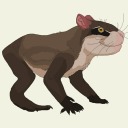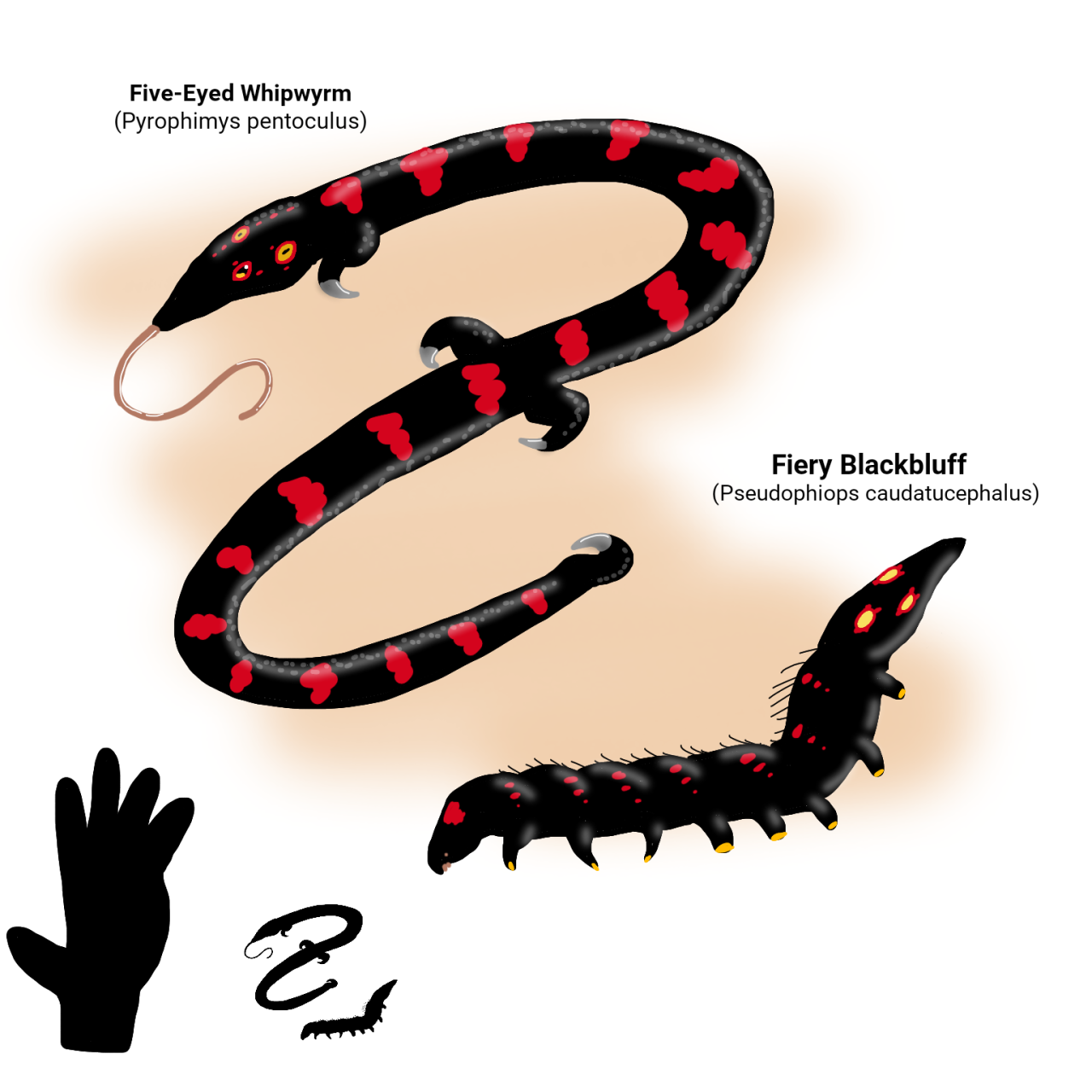Today as abundant and diverse as they were back on their home planet, the ants were among one of the most successful terrestrial invertebrates that had been introduced to HP-02017. Descended from a select few species, introduced as detritivores, pollinators and seed dispersers, these remarkable hymenopterans have since spread across the globe and occupied the niches similar to Earthly ants, such as seed-eaters, leaf-cutters, scavengers, predators, fungus farmers and even honeydew-ranchers: though the livestock of those ranchers are somewhat different, with the niches of sap-sucking true bugs instead filled by beetles and lepidopterans.
Some species, however, have begun taking on niches unlike any of their Terran forebearers. Raftants, aquatic species native to floodplains, developed specialized castes to act as oars and floaters to propel the colony along the surface. Perhaps stranger, at least for ants, are the lonestingers: ants that no longer live in colonies and have become solitary, with all individuals being winged and wasplike, no longer producing wingless sterile workers and taking on a niche akin to solitary wasps and bees.
One of the most unusual species in the Middle Temperocene, however, are the lime ants (Citromyrmex polyregina), an abundant and widespread species found all across South Ecatoria and the neighboring islands. Easily recognizable by their distinct yellow and black coloring, these ants are generalist omnivores diet-wise: consuming both plant and animal matter, though prioritizing carbohydrate-rich sugary food like fruit, sap and nectar for the active adults, while saving protein-rich seeds, bugs and meat to the larvae to encourage their growth. Like most ants, they communicate by pheromones, travelling across the forest floor in single file to scout out food sources they can carry back to the colony. They, too, have specialized castes for their vital activities, such as small minor workers that participate in foraging and nest cleanup, major workers that act as heavy lifters and back-up defense, and soldiers, armed with large heads and powerful mandibles who defend the nest, cut up large pieces of food, and even ferry around the smallest workers hitchhiking on their bodies.
But one truly remarkable characteristic of the lime ant is its behavioral flexibility, thanks to an unusual recessive gene, the Q gene, that causes the species to produce three separate types of queens, depending on which alleles they acquire. Each one lives a completely different lifestyle: one that affects the behavior of their corresponding colonies as well. These genes mix together during nuptial flights, where alates from different colonies pair together queens and drones that in turn, produce offspring that are homozygous QQ, heterozygous Qq, or homozygous qq. This is further complicated by male ants being haploid, and thus males are always only Q or q.
Homozygous QQ queens develop into what is known as the despot morph: a sedentary, highly-aggressive queen with a bulky body and large mandibles. Her colony dwells in a fixed, permanent nest that occupies the same space for as long as she lives, which can be as long as fifteen years. During which time, their nests can grow into immense proportions, spanning tunnels and chambers many meters across and inhabiting up to 100,000 inhabitants. Despot morph queens tolerate no other reproducing female in the colony, and a single despot morph queen rules supreme: aggressively killing any other breeding female in her nest, be they rival invaders, her own alate daughters, or a worker that starts laying unfertilized eggs. All of her genetically fatherless drone offspring will be Q drones. If she mates with a Q drone, all her female offspring will be despot morphs as well, and if she mates with a q drone, half her offspring will be despot morphs, and half her offspring will be Qq heterozygous: the communal morphs.
Communal morphs, the second kind, are long-bodied and capable of traveling long distances on foot, unlike the sedentary despot morph. These queens, the most common kind, are different from despot morphs in another way: they tolerate the presence of other communal morph queens, thus producing a polygyne colony that is much larger than those of despot morphs, with as many as nine or ten queens and colonies growing to up to a million or more. Their large colony size instead favors them to constantly be on the move, foraging for food in an area and building smaller temporary nests and moving on once food becomes depleted in migrations every few months, with the queens marching along in the swarms and the brood carried by the workers as they go. With multiple queens that can be regularly replaced as they die, the colony as a whole can survive significantly longer than those of a despot morph, which is important as their nomadic lifestyle also leaves them with a higher mortality rate due to exposure to environmental factors and predators. Being heterozygous Qq, they can produce either Q drones or q drones, and a communal morph queen that mates with a Q drone will produce half despot morph offspring and half communal morph offspring, and a communal morph queen that mates with a q drone will produce half communal morph offspring and half qq homozygous offspring: the usurper morph.
Usurper morphs are unusual as they do not build colonies at all: they never shed their wings and remain solitary, similar to the lonestingers. As they disperse from their parent colony during the nuptial flight, they mate once with a drone and store his sperm, but do not start laying eggs right away. Instead, over the course of their long lifespan which may last many years (but rarely as long as the despot and communal morphs), the usurper queen instead infiltrates the nests of the other two kinds shortly before the nuptial flights begin, lays her eggs inside, and leaves all the effort of childcare to the workers of the colonies. Covering the eggs with pheromones to trick the colony into accepting them, she functions in essence as a solitary brood parasite whose progeny are raised by others. As she does not form a colony: none of her offspring become workers and soldiers, and instead always hatch into queens or drones: drone offspring are always q as they are born from unfertilized eggs. If she mates with a Q drone, half of her daughters will be communal morphs and half will be usurpers, and if she mates with a q drone, all her daughters will be usurper morphs.
This unusual arrangement likely evolved as an advantageous trait due to fickle, changing seasons and environments, allowing the species as a whole to persist. When food is plenty despot morphs become more common, able to defend a productive patch of land. When food is scarcer, communal morphs dominate, able to travel long distances to scout out new foraging grounds. And when times are the toughest, the most common morph becomes usurpers: being solitary, they need less food than a whole colony and can depend on the few hardy colonies to rear their young. Through a complex set of environmental dynamics, genetic inheritance, and competition between the queen types, the lime ant proves itself an adaptable and tenacious species that finds great success in the forest floor ecosystems of South Ecatoria.
Despite its complicated and bizarre life history, however, the local northhounds that occupy its range, in particular the vulpins, have found a rather mundane use for this abundant species. When threatened, major workers spray formic acid from specialized nozzles in their abdomens as a ranged mechanism. This, however, has been exploited by the vulpins who intentionally provoke the ants to get them to spray their acid onto food items: in effect acting as both a preservative to ward off fungal and bacterial growth on food, and as well as a seasoning that imparts a sour, citrus-like flavor onto said food. While toxic in large quantitities, the ants’ formic acid is harmless in small amounts to larger creatures like the northhounds: making for a surprisingly ideal additive in the vulpins’ cultural fondness of imparting different tastes in their primitive form of ‘cuisine’.
————-






















